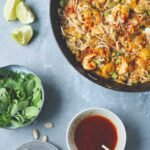Print Recipe
Nutrition Facts
Pad thai
Amount Per Serving
Calories 556
Calories from Fat 90
% Daily Value*
Fat 10g15%
Saturated Fat 2g13%
Trans Fat 1g
Polyunsaturated Fat 2g
Monounsaturated Fat 4g
Cholesterol 130mg43%
Sodium 10883mg473%
Potassium 1628mg47%
Carbohydrates 90g30%
Fiber 17g71%
Sugar 25g28%
Protein 33g66%
Vitamin A 7189IU144%
Vitamin C 187mg227%
Calcium 288mg29%
Iron 6mg33%
* Percent Daily Values are based on a 2000 calorie diet.
Pad thai
Add homemade kimchi to spice up this classic Thai dish.
Servings: 4 people
Calories: 556kcal
Equipment
- Large bowl
- Jar
- Small pan
- Wok
Ingredients
For the kimchi (fills 1 litre jar):
- 90 g fine sea salt
- 2 Chinese cabbages about 1kg, shredded
- 2 garlic cloves finely chopped
- 5 cm fresh ginger peeled and finely chopped
- 2 tbsp Korean chilli flakes
- 2 tbsp fish sauce
- 2 carrots grated
- 5 spring onions thinly sliced
For the pad thai:
- 200 g flat rice noodles (dried weight), or use 600g ready-cooked flat rice noodles
- 1 tbsp tamarind paste
- 3 tbsp fish sauce
- 1 tsp sugar
- 1-2 tsp chilli flakes or use fresh chilli
- 2 tbsp vegetable oil plus extra for the noodles
- 300 g diced chicken or tofu or prawns
- 1 onion thinly sliced
- 2 garlic cloves finely chopped
- 2 eggs lightly beaten
- 40 g cashews or peanuts roughly chopped
- bunch of spring onions thinly sliced
- 150 g kimchi
- 200 g beansprouts
To serve:
- small bunch of mint leaves roughly chopped
- small bunch of basil leaves roughly chopped
- more fish sauce to taste
- more chilli flakes or chilli sauce to taste
- 1 lime cut into wedges
Method
- For the kimchi: In a large bowl, rub the salt thoroughly through the cabbage, and allow it to soften and form a little brine for an hour or so. In a small cup, make a paste by combining the garlic, ginger, chilli flakes and fish sauce. Using a colander, drain the cabbage so that you retain some of the brine in a bowl. Combine the carrots and spring onions with the cabbage, and stir through the hot fishy sauce. Add a little brine if you need to loosen the mix. Spoon the kimchi into a jar, pressing down well to exclude air bubbles. Use a freezer bag part-filled with water to keep the vegetables submerged and seal the jar. Allow the kimchi to ferment for five days at room temperature. The kimchi should have a pleasingly sour taste. Leave to ferment in the fridge for a few days (or weeks) if you prefer it sourer.
- For the pad thai: If using dried noodles, cook them according to the packet instructions, then drain and toss in a few drops of oil so they don’t glue together.
- Make the sauce by combining the tamarind, fish sauce and sugar in a small pan; bring to the boil to dissolve the sugar. Add the chilli flakes or fresh chilli to taste and put to one side.
- In a large pan, ideally a wok, heat the vegetable oil over a high heat. Add the chicken (or prawns/tofu) and the onion and stir-fry for eight minutes, until coloured and just about cooked through. Add the garlic and beaten egg to the pan for the final two minutes of stir-frying time.
- Add the noodles and stir-fry for a further three minutes, making sure that the chicken is cooked through. Add half the nuts, the spring onions, kimchi and beansprouts and fry for a minute to combine.
- Stir through the sauce and cook for a minute longer before removing from the heat.
- To serve, sprinkle with the remaining nuts and all the herbs. Add a splash more fish sauce/chilli if you fancy and serve with the lime wedges. Add a dash of kimchi.
Nutrition
Calories: 556kcal | Carbohydrates: 90g | Protein: 33g | Fat: 10g | Saturated Fat: 2g | Polyunsaturated Fat: 2g | Monounsaturated Fat: 4g | Trans Fat: 1g | Cholesterol: 130mg | Sodium: 10883mg | Potassium: 1628mg | Fiber: 17g | Sugar: 25g | Vitamin A: 7189IU | Vitamin C: 187mg | Calcium: 288mg | Iron: 6mg
